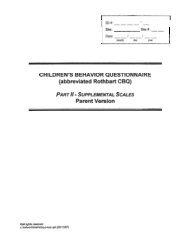A Contextual Investigation of Three-Digit Addition and Subtraction
A Contextual Investigation of Three-Digit Addition and Subtraction
A Contextual Investigation of Three-Digit Addition and Subtraction
Create successful ePaper yourself
Turn your PDF publications into a flip-book with our unique Google optimized e-Paper software.
D’Metrius: You still don’t have to have boxes, rolls, pieces. It don’t have to<br />
be up there ‘cause you know these are pieces, rolls, <strong>and</strong> boxes.<br />
Jess:<br />
A CONTEXTUAL INVESTIGATION OF THREE-DIGIT ADDITION AND SUBTRACTION 149<br />
I just know that . . . I remember boxes, rolls, <strong>and</strong> pieces help me.<br />
It appeared from the conversation that many <strong>of</strong> the students evoked the imagery <strong>of</strong><br />
the c<strong>and</strong>y factory as they interpreted <strong>and</strong> solved these tasks. This conjecture was corroborated<br />
by the observation that as they worked in pairs on activity sheets, many <strong>of</strong> the<br />
students continued to explain <strong>and</strong> justify their solutions in terms <strong>of</strong> activity in the c<strong>and</strong>y<br />
factory. In some instances, the students actually drew boxes, rolls, <strong>and</strong> pieces to support<br />
their solutions. The many personally meaningful ways <strong>of</strong> solving the tasks that emerged<br />
are shown in figure 18.8. These included adding from the left (fig. 18.8a), adding from<br />
the right (fig. 18.8b), <strong>and</strong> working from a drawing <strong>and</strong> recording the result (fig. 18.8c).<br />
1<br />
2 7 3<br />
+ 1 9 4<br />
3 16 7<br />
4 6<br />
(a)<br />
1<br />
2 7 3<br />
+ 1 9 4<br />
4 6 7<br />
(b)<br />
1<br />
2 7 3<br />
+ 1 9 4<br />
4 6 7<br />
(c)<br />
3<br />
Fig. 18.8. <strong>Three</strong> different solutions to the problem 273 + 194<br />
CONCLUSION<br />
We have outlined an instructional sequence designed to support students’ construction<br />
<strong>of</strong> their own personally meaningful algorithms for three-digit addition <strong>and</strong> subtraction<br />
as it was conducted in one third-grade classroom. Although the situation-specific<br />
imagery <strong>of</strong> the c<strong>and</strong>y factory appeared to support most <strong>of</strong> the students’ activity, the<br />
influence <strong>of</strong> their prior participation in the practices <strong>of</strong> school mathematics became<br />
apparent when they discussed which types <strong>of</strong> solutions were legitimate <strong>and</strong> easier to<br />
comprehend. However, they did seem to modify their views about what it means to<br />
know <strong>and</strong> do mathematics (at least when interacting with McClain as the teacher) as<br />
they compared <strong>and</strong> contrasted solutions. The important norm that became established<br />
was that <strong>of</strong> explaining <strong>and</strong> justifying solutions in quantitative terms. We find this sig-






